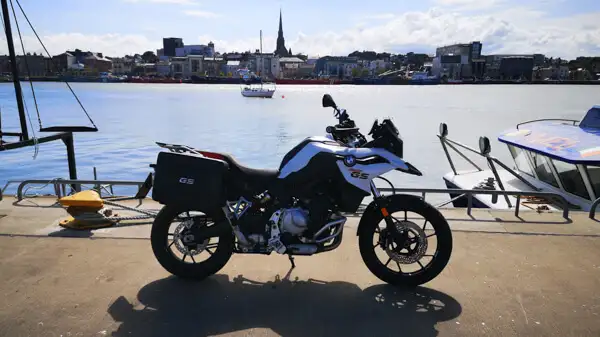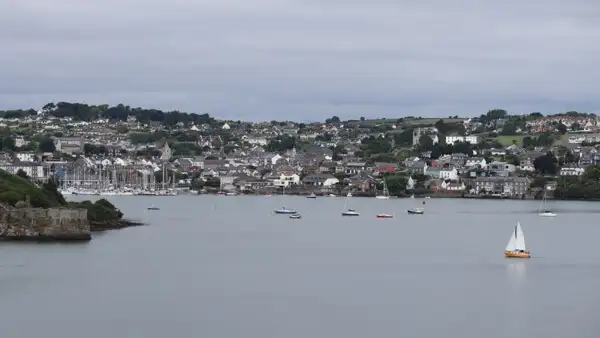Hours or days of holiday driving on the motorway (highway) – by motorbike – is that fun? Probably not.
More and more motorcyclists pack their motorbike onto the motor trailer, drive to their holiday destination by car and only start their motorbike tour there.
Page Contents (click line to jump the text)

Intro
Some advantages: Riding in a car on the motorway is more pleasant than on a motorbike, especially in bad weather. You get more kilometres done in a day, especially if you can rotate with several riders. It’s usually more fun with friends together, you can listen to music and chat, and you can also carry a lot more luggage.
Also, you can take a motorbike on holiday without a fairing or windshield – in the holiday country on small country roads you don’t need a windshield and you’ve avoided the motorway.
Does that make sense for a rider alone? Why not, it’s your decision.
If you have and know your own trailer, you can safely move on to the next article.
But if you’re planning to rent a motorbike trailer for your holiday and don’t have much experience, I’ve written a few tips for you in this article.
I transport motorbikes with my own trailer for a living – for my motorbike rental business in Ireland (update: we have closed the shop in the meantime…)
In addition to our own trailer, we have also used various rental trailers and are therefore familiar with many different models.
Disclaimer: Legal information you have to research yourself. I am not a lawyer and my experience is not legally binding.
If you make mistakes when loading or lashing, it can be expensive – I would like to spare you that, so that you can go on holiday safely and relaxed.
What is the towing capacity of the towing vehicle?
You have a car with a trailer coupling – great! Then you can rent a motorbike trailer for your holiday. Trailer rentals are easy to find via Google – off you go…
Not so fast: Check your vehicle registration, there is an entry for the maximum permissible trailer load, e.g. 1.8 tonnes. If you use this to the full, the trailer will be difficult to drive. I would stay well below the maximum, especially if you want to drive through mountainous regions.
So, now you can have a look at the possible trailers on the homepage of the rental company. There you will also find a tare weight and a maximum load. Even there, I wouldn’t push the limits. Maybe some trailers are already out of the question, others are on the shortlist now.
Then add up the weights of the motorbike or the planned motorbikes. Caution: The manufacturer’s specifications for motorbikes are sometimes with liquids, sometimes without and sometimes with 90% tank filling, etc… you may have to correct them.
In any case, you must add estimated weights for attachments and luggage. If you calculate empty and load fully, you may quickly exceed the permitted payload.
Does everything still fit? Then you’re ready to go. If not, at least you know and can think of alternatives.

Trailers – with or without Brakes?
There are trailers with overrun brakes and trailers without. What is this?
In simple terms, when you brake with the car, the trailing trailer presses against the trailer coupling.
This triggers a brake mechanism on the trailer and the wheels on the trailer are braked. This serves to support the car and helps to improve the stability of the combination.
If you want to transport several and heavy motorbikes, I would recommend a trailer with brakes. However, it is usually heavier, because additional technology also adds weight. It depends on your payload.
Small light trailers for one or two (light) motorbikes are often unbraked. With less weight on the trailer, they are also easy to handle. I would not necessarily drive heavy motorbikes with an unbraked trailer, even if the payload allows it.
You can usually find the data on the homepage of the rental company.
How fast am I allowed to drive with a trailer?
That depends: In Germany, a car trailer is only allowed to drive at 80 km/h. There are trailers for which you can apply for a 100 km/h permit if they are technically suitable. There are trailers for which you can apply for a 100 km/h permit if they are technically suitable for this, which requires brakes and suspension, among other things.
The tyres must not be older than 6 years, otherwise the trailer will lose the 100 km/h registration or it will be invalid in the event of a police check.
The 100 km/h registration is entered in the vehicle registration certificate of the trailer and the trailer is given a “100” sticker on the rear. You can easily find out from the rental company whether the rental trailer has this registration.
Does this also apply abroad? Well, German law only applies in Germany – other countries, other regulations. In Ireland, for example, a trailer is only allowed to drive 80km/h. It is therefore a good idea to look up the speed limits for the countries that you will be passing through.
How many motorbikes go on the trailer?
Well, if it has three front wheel brackets, it can probably load three motorbikes, right? Not necessarily!
Calculate a width of approx. 80cm and a length of 210-235cm per motorbike. Then read the width and length of the loading platform.
A trailer with a width of 163 cm and a length of 210 cm can load two motorbikes. If you only drive with one motorbike and have a third bar, you can place your motorbike in the middle – great!
My trailer measures 301cm in length and 183cm in width on the platform and can actually carry 3 bikes – how does that work?
Because it’s a bit longer, you can stagger the bikes a bit and then the handlebars will fit. Either the middle bar comes back a bit, or the middle and the left bar is set back a bit – depending on the motorbikes.
But beware: If you want to load boxer models (BMW G1250GS), then only two motorbikes will fit – the boxer engines are simply too wide.
How are the motorbikes loaded onto trailers?
There are various possibilities:
Lowering trailers: With these models you can lower the platform hydraulically and then drive onto the trailer, usually into a front wheel rocker. These are great trailers if you have to load alone, because loading and unloading is very safe.
Folding loading ramp at the rear: Similar to the previous method, you can drive onto the trailer. However, it is not lowered, but a loading ramp attached to the rear is used for this.
Platform: You just have a platform and then there are ramps on which the motorbike is rolled up. How do you get on the platform? I use a second rail so I can walk alongside the motorbike. With many platform trailers, one or two rails can be stowed under the platform. If you rent the trailer, make sure you have two platforms with you. I strongly recommend loading with two people, because things can get tippy quickly.

Open rail systems: Mostly found on light, unbraked trailers. You roll the bike over a loading rail onto the transport rail, where it is then lashed down. You balance around the bike yourself – I would also prefer to load it in pairs.
By the way, at least in the beginning, I would not drive onto the trailer with motor assistance if you are not sitting on the motorbike. It’s too easy to lose your balance, accidentally accelerate and then things can quickly get tricky.
When you unload, the motorbike rolls backwards down the ramp next to you. The front wheel exerts little pressure on the ground and can therefore slide easily. Then the locked front wheel slides and the motorbike continues to roll down the ramp – scary! The front brake does not work very well backwards downhill.
To keep the bike under control going downhill backwards, you can also put the bike in first gear (engine off) and then let the clutch come up to the drag point. If the bike is going too fast, just let go of the clutch lever and stand still again. The rear wheel has more weight than the front wheel when going downhill in reverse and does not slide on the ground. That is why “braking with the clutch” works very well in reverse.
How are the motorbikes fixed and lashed to the trailer?
It is essential that the front wheel presses against a firm resistance so that the motorbike can support itself to the front when the trailer brakes. Straps alone could otherwise tear.
A fixed front wall works, but often there are open front wheel bars that you drive into. Then you have to put the motorbike on the side stand or a second person holds the vehicle so that you can lash it. When lashed, the motorbike should stand upright.
With front wheel rockers you drive over a small rocker into a front wheel rail. Behind the wheel, a rail also folds up to hold the front wheel in place. If this fits well, the bike is already held upright and you can let it go and move on to lashing – great stuff!
Rental companies don’t usually provide lashing straps, for insurance reasons. You will have to buy or rent lashing straps. You should make sure that they are of good quality, because I’ve had many a broken strap – and they were usually the DIY store crap quality.
Good, high-quality lashing straps are available from specialist motorbike dealers (Louis or Polo), or from good specialist markets for tradespeople.
If the trailer offers closed lashing rings, you can use lashing straps with closed hooks (spring-loaded carabiners). These are absolutely preferable, because even if the motorbike bobs in the suspension, the hook does not lose its hold.
Sometimes you can also achieve a closed attachment to the hanger with lashing loops (short closed belt loops). By threading the loops through a rear bar or similar and then hooking the lashing strap into the loop.
If you only have open sharp-edged sheet metal holes in the platform as lashing points, then you must use lashing straps with open hooks that you can hook in there. Note: There are short and long hooks – use the long ones! You can forget about the short hooks, they come out of the anchor hole immediately when the motorbike rocks.
Lashing points on the motorbike: I do not recommend using the handlebars, because I have already bent several handlebars myself with them.
The triple clamp (metal triple clamp of the front suspension) is suitable. You put two strap loops around the spring bars above the triple clamp and hang the lashing strap hooks there.
Why not use the lashing strap directly? Be careful with metal parts, they can damage your motorbike.
Then tension the lower lashing hooks slightly forwards and sideways. With this you pull the motorbike into the suspension and the front wheel into the front wheel bracket.
The motorbike should be pulled well into the springs at the front and rear so that it does not bob and jump on uneven ground.

Some also put a strap over the front wheel axle. One hook is hooked into the ground in front of the front wheel and the other behind it. Again, the straps point slightly outwards to keep the front wheel on the ground and fixed to the side. Here the motorbike is not pulled into the suspension, but this can be achieved by using more straps.
Other lashing points on the motorbike are the subframes of the passenger footrests, the frame on the side and attachments such as luggage racks or pannier holders.
If you lash the motorbike with two straps to the front (straps pointing outwards) and tension another two straps to the rear (straps pointing sideways), then the motorbike is initially fixed and pulled into the suspension. In the meantime, I still use two straps on the side, which I attach to the frame. They keep the bike reliably straight even in curves and are also a backup in case one of the other straps breaks.
Lashing straps and lashing equipment – what do I need?
I calculate at least six good lashing straps and six strap loops per motorbike. Add to that a few pieces in reserve.
If I want to be prepared for different trailers, I carry several lashing straps with closed hooks and several with open hooks, then I am flexible.
There are also other lashing aids, but you will get very far with lashing straps and strap loops.
What other accessories should I have with me?
If you have to load via a loading rail, you should have two of them with you, one for the motorbike and one on which you can walk along next to the motorbike.
A trailer lock helps against theft, both when the trailer is unhitched and when it is parked attached.
Every trailer should be equipped with two wedges. You can use them to secure the wheels against rolling when parked.
For longer journeys it also makes sense to have a spare wheel, a jack and a wheel hub spanner.
A small mobile compressor is also a good thing – for the motorbike too.

Rental: How is the motorbike trailer insured – what about when travelling abroad?
Often overlooked, but important in case of damage: How is the trailer insured?
How high is the excess? Is there additional insurance to reduce your own risk?
What about travelling abroad? Are there countries to which I am not allowed to travel?
Talk openly with the rental company about your travel plans and the possibilities so that there are no unpleasant surprises later.
A few more tips
You can always see people loading their motorbike trailers onto the small garden trailer they already have in order to save money on renting a motorbike trailer. If your garden trailer has a suspension, is technically in order (lights) and you can load and lash your motorbike well, there is nothing to be said against it.
But be careful, I wouldn’t recommend unsuspended “cheap trailers” with tiny wheels, because they might not be very stable, or they might bounce on every bump – with the motorbike!
When hitching up, you should also pay close attention: Is the trailer firmly attached to the trailer hitch? Is the lock engaged? Is the wire loop laid over the trailer coupling? Is the cable connected properly and are all the lights working?
Now crank up the front wheel and release the parking brake and you’re ready to go!
The first time, have a friend or your landlord show you around.
Have a good trip!
More interesting articles for you
PREPARING A MOTORBIKE TRIP TO IRELAND – WHAT IS THE BEST WAY TO GET TO THE ISLAND?
THE 13 MOST BEAUTIFUL MOTORBIKE TOURS ON THE IRISH ISLAND
MOTORBIKE TRIP IRELAND – WHICH REGION SHOULD I GO TO?
PREPARING FOR A MOTORBIKE TRIP IN IRELAND – ROUTE SELECTION AND NAVIGATION
Photo credits cover photo: Motorbikes loaded on a trailer, photo by Ulrich Knüppel-Gertberg (www.irland-insider.de, www.ireland-insider.com)